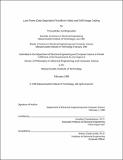| dc.contributor.advisor | Anantha Chandrakasan. | en_US |
| dc.contributor.author | Xanthopoulos, Thucydides | en_US |
| dc.date.accessioned | 2005-05-19T14:19:19Z | |
| dc.date.available | 2005-05-19T14:19:19Z | |
| dc.date.copyright | 1999 | en_US |
| dc.date.issued | 1999 | en_US |
| dc.identifier.uri | http://hdl.handle.net/1721.1/16715 | |
| dc.description | Thesis (Ph.D.)--Massachusetts Institute of Technology, Dept. of Electrical Engineering and Computer Science, 1999. | en_US |
| dc.description | Includes bibliographical references (p. 139-144). | en_US |
| dc.description | This electronic version was submitted by the student author. The certified thesis is available in the Institute Archives and Special Collections. | en_US |
| dc.description.abstract | This work introduces the idea of data dependent video coding for low power. Algorithms for the Discrete Cosine Transform (DCT) and its inverse are introduced which exploit statistical properties of the input data in both the space and spatial frequency domains in order to minimize the total number of arithmetic operations. Two VLSI chips have been built as a proof-of-concept of data dependent processing implementing the DCT and its inverse (IDCT). The IDCT core processor exploits the presence of a large number of zerovalued spectral coefficients in the input stream when stimulated with MPEG-compressed video sequences. Adata-driven IDCT computation algorithm along with clock gating techniques are used to reduce the number of arithmetic operations for video inputs. The second chip is a DCT core processor that exhibits two innovative techniques for arithmetic operation reduction in the DCT computation context along with standard voltage scaling techniques such as pipelining and parallelism. The first method reduces the bitwidth of arithmetic operations in the presence of data spatial correlation. The second method trades off power dissipation and image compression quality (arithmetic precision.) Both chips are fully functional and exhibit the lowest switched capacitance per sample among past DCT/IDCT chips reported in the literature. Their power dissipation profile shows a strong dependence with certain statistical properties of the data that they operate on, according to the design goal. | en_US |
| dc.description.statementofresponsibility | by Thucydides Xanthopoulos. | en_US |
| dc.format.extent | 175 p. | en_US |
| dc.format.extent | 2901986 bytes | |
| dc.format.extent | 2901742 bytes | |
| dc.format.mimetype | application/pdf | |
| dc.format.mimetype | application/pdf | |
| dc.language.iso | eng | en_US |
| dc.publisher | Massachusetts Institute of Technology | en_US |
| dc.rights | M.I.T. theses are protected by copyright. They may be viewed from this source for any purpose, but reproduction or distribution in any format is prohibited without written permission. See provided URL for inquiries about permission. | en_US |
| dc.rights.uri | http://dspace.mit.edu/handle/1721.1/7582 | |
| dc.subject | Electrical Engineering and Computer Science | en_US |
| dc.title | Low power data-dependent transform video and still image coding | en_US |
| dc.type | Thesis | en_US |
| dc.description.degree | Ph.D. | en_US |
| dc.contributor.department | Massachusetts Institute of Technology. Department of Electrical Engineering and Computer Science | |
| dc.identifier.oclc | 42647593 | en_US |
